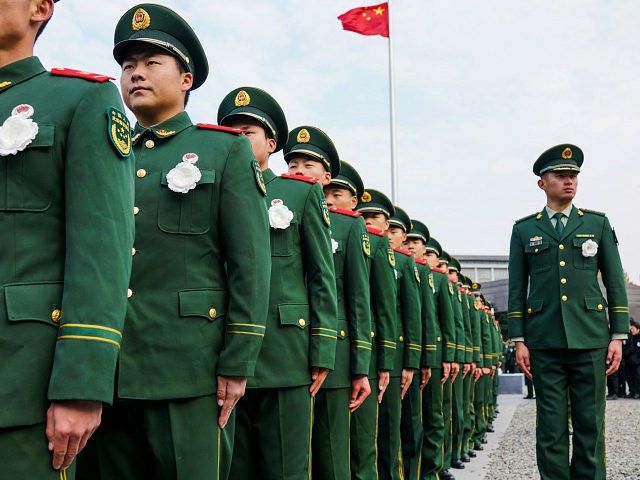Up to 5,000 Chinese troops are now massed along the disputed Ladakh border with India, and according to Indian officials, not all of them are staying on China’s side of the Line of Actual Control (LAC).
Tensions along the border have grown steadily over the past three weeks, following the latest in a bizarre series of fistfights and rock-throwing incidents between Indian and Chinese soldiers.
Indian media outlets have a habit of describing the opposing troops as “eyeball-to-eyeball” in key locations along the LAC, a phrase that captures both their proximity to each other and the amount of angry glaring each side is directing at the other. The Hindustan Times reported on Tuesday:
Indian and Chinese soldiers are eyeball-to-eyeball at four locations along the LAC and several rounds of talks between local military commanders , including a meeting on Monday, have failed to end the standoff that began with a violent confrontation between rival patrols three weeks ago near Pangong Tso.
There have been troop reinforcements by China, around 5,000 of whose troops may now be present in the region, two officials said on condition of anonymity. The Chinese forces are not concentrated anywhere near the flashpoints, but scattered on their side, the officials said.
Sending the military reinforcements, including troops, vehicles and heavy equipment, did not require much effort as China diverted the resources from an ongoing military exercise in the region, said one of the officials cited above.
India is tracking all aspects of the Chinese deployments and parity in troop numbers is being ensured, said the second official cited above.
China’s state-run media has described the latest tensions as the worst since the 2017 Doklam standoff that lasted 73 days.
The Doklam standoff also featured Indian and Chinese soldiers throwing rocks at each other and getting into wild brawls along the border. The Doklam affair, which began when Chinese engineers tried to build a road through the Himalayas that ran through territory claimed by Bhutan, ended with China “losing” by backing down on its planned road construction, but also “winning” by building other infrastructure projects in the region, unopposed by either India or Bhutan.
The Ladakh crisis also involves a road, this time built by India. The road was clearly built on Indian territory, but the Chinese apparently became nervous that it could help the Indians expand their influence through the region.
The Chinese military responded with its own infrastructure surge, including some camps that appear to be situated on India’s side of the LAC, based on satellite photographs. India claims Chinese troops have crossed the border several times using ground vehicles, helicopters, and motorboats.
The Indian Express quoted observers who found it either disturbing or reassuring that the Chinese Foreign Ministry did not mention Ladakh at all during its weekend press conference. The disturbing implication is that China intends to continue unilaterally redrawing the LAC without discussion; the reassuring possibility is that China wants to settle the matter through quiet diplomacy:
“China’s actions are hard to decipher, especially in the absence of any authoritative statements from Beijing,” said Taylor Fravel, Professor of International Relations at MIT and author of two major books on China’s territorial disputes and its military strategy.
“The simplest explanation perhaps is that China is responding to India’s efforts to bolster border-area infrastructure in Ladakh after the completion of the DSDBO road. After India’s move into Doklam in 2017, China is perhaps especially sensitive to Indian activity along the disputed border. Around Galwan, in particular, China may be seeking to pre-empt an Indian effort to improve its links to the LAC”, he added.
But Ashok Kantha, who was India’s ambassador to China from 2014 to 2016, argues that the Chinese “seem to be in fact physically changing the ground position and preventing our troops from undertaking regular patrolling.”
“There are some major changes from the earlier pattern of what we have witnessed with regard to the Chinese behavior on the border: one, they have reportedly come in large numbers into a new area (Galwan river valley) which had not been contentious in terms of the alignment of the LAC; two, they are staying put, dug down and in tents and not just as a short-term patrol; three, these incursions are happening in multiple locations; and four, they have become more assertive and aggressive in their behavior,” he said.
NDTV reported India is moving more of its own troops into the Ladakh region and is confident it can maintain a superior balance of forces with the Chinese.
“It is serious. It is not a normal kind of transgression,” a former Indian Army commander said, while an Indian security analyst agreed the situation is “not a routine standoff.”
Outlook India said Chinese troops have penetrated up to four kilometers into Indian territory, calling it “China’s first attempt to make alterations on this part of the Line of Actual Control” since its 1962 border war with India. Beijing’s goal appears to be changing the facts on the ground until the border has been effectively redrawn to its tastes, making an unthinkable shooting war India’s only option for resisting the incursion.
“Not a single bullet has been fired as per the agreement between India and China. Border altercations are usually limited to fist and elbow fights. But this time, there are reports of sticks and iron rods being used,” Outlook India reported.

COMMENTS
Please let us know if you're having issues with commenting.